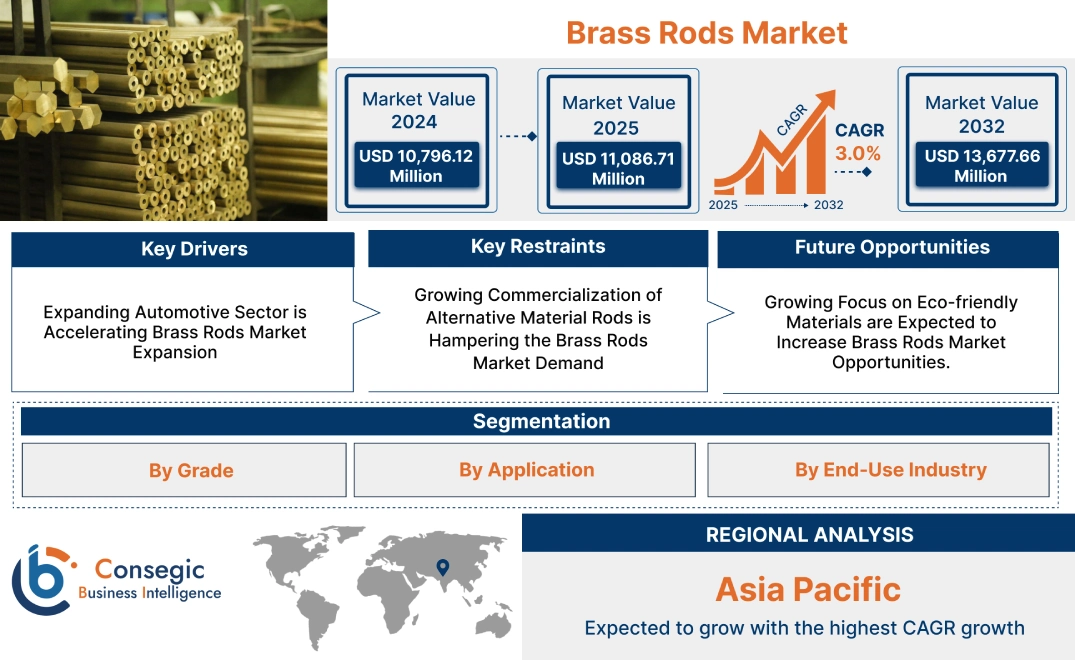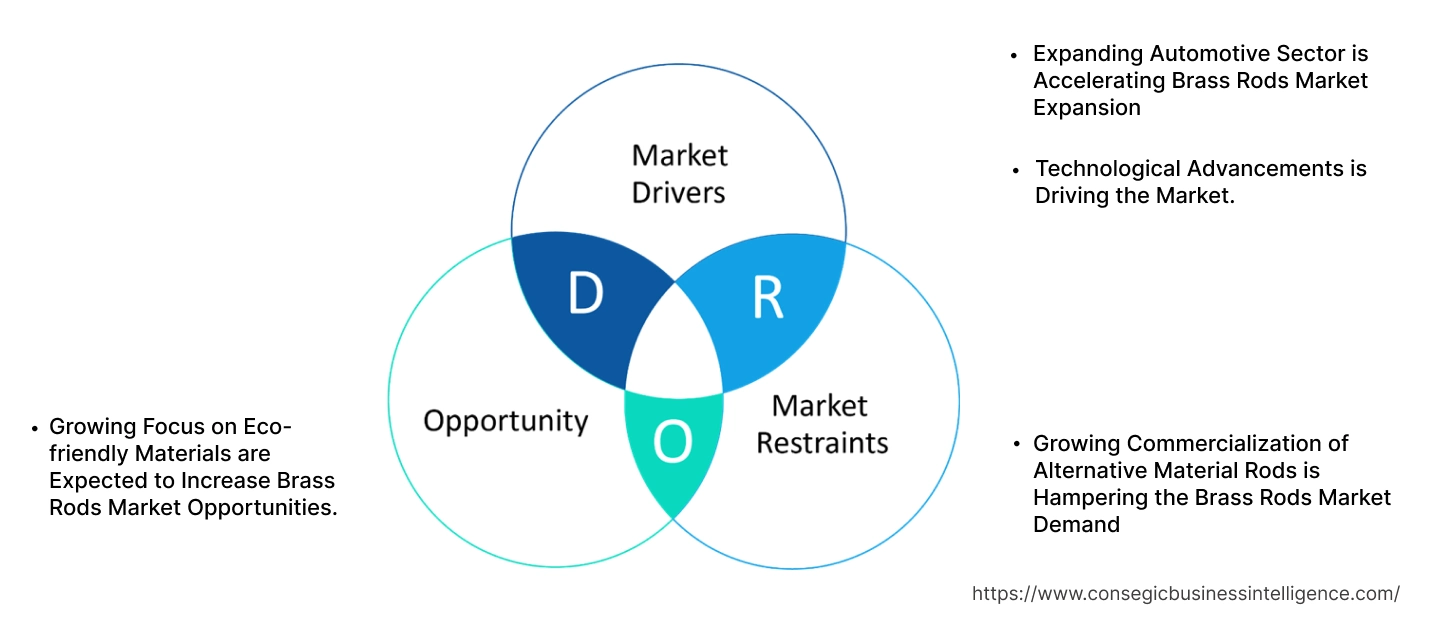- Summary
- Table Of Content
- Methodology
Brass Rods Market Size:
Brass Rods Market size is growing with a CAGR of 3.0% during the forecast period (2025-2032), and the market is projected to be valued at USD 13,677.66 Million by 2032 from USD 10,796.12 Million in 2024. Additionally, the market value for the 2025 attributes to USD 11,086.71 Million.
Brass Rods Market Scope & Overview:
Brass rods are metal bars. They are made from a mixture of copper and zinc. They are strong and durable. They are resistant to dust. They are easy to cut and shape. Machining with them is also easy. These rods come in solid or hollow form. They also come in different grades. Free-cutting grade is easy to cut and machine. They are used to make screws and bolts. Naval grade is resistant to water. High-tensile grade is stronger when compared to others. These rods are used in many sectors. They are used to make valves. It controls water and gas. Moreover, they are used to manufacture gauges. It is useful in measuring pressure. Screw, bolts, casings, and others are also manufactured through it. In addition, these rods come in various shapes. This includes round rods, square rods, hexagonal rods, and others.
Key Drivers:
Expanding Automotive Sector is Accelerating Brass Rods Market Expansion
The automotive sector involves production of vehicles. This includes cars, trucks, buses and others. Rods made from brass are used in manufacturing many automotive parts. This includes radiators and fuel system. Due to its high strength, it is used in production of brake fittings and connectors. Brass fasteners and valves are also made using these rods. They are corrosion resistant. The demand for commercial vehicles has increased globally.
For instance,
- According to the ACEA, the sales of van in European Union increased by 8.3% in year 2024. This has required rods made of brass to manufacture the vehicle parts.
Overall, the expanding automotive sector is significantly boosting the brass rods market expansion.
Technological Advancements is Driving the Market.
The development of new alloys is being carried out. These new alloys are developed to make rods more specific. Special rods with specific alloys are used in different sectors. Lead-free brass is one such example developed for rods. Moreover, these new alloys pass environmental regulations. This includes wastage reduction. It also includes energy saving processes. In addition, new technologies are also changing the market landscape.
For instance,
- Gnee Steel Co., Ltd. published an article in 2023 stating that new machines are reducing the limitation of traditional manufacturing. With new machines, key players are manufacturing rods in less time. They also stated that new machineries have made rods quality more better. This has increased their application and reach.
Thus, technological advancements are accelerating the global brass rods market growth.
Key Restraints:
Growing Commercialization of Alternative Material Rods is Hampering the Brass Rods Market Demand
The market faces competition from other substitutes available in the market. This includes stainless steel, aluminum, and plastic. Aluminum rods are more used in different sectors. It is because of its lightweight nature. It is also more easier to shape. This makes it a popular choice in automotive and construction. Moreover, stainless steel rods are stronger than brass made rods. This material does not rust easily. Owing to this feature, it is more used in kitchen appliances. The stainless-steel materials are also used to manufacture plumbing materials and medical devices. Additionally, in some sectors plastic rods are used. It is because of its lightweight nature compared to brass. Plastic materials are easy to manufacture. These alternatives are cheaper than brass. They are readily available in the market. Furthermore, these alternatives have more strong electricity conductivity. All these factors are helping them gain more market share. Hence, the growing commercialization of alternatives is hampering the brass rods market demand.
Future Opportunities :
Growing Focus on Eco-friendly Materials are Expected to Increase Brass Rods Market Opportunities.
People are becoming aware of material that harms the environment. They are seeking eco-friendly options. Governments are also understanding climate changes. They are passing regulations to adopt more sustainable practices. They are providing incentives and funding to organizations to adopt materials which benefit the environment. Rods made from brass are considered more eco-friendly. They are less harmful than alternatives.
For instance,
- Visual Capitalist published an article in 2024 stating rods made with brass are a sustainable option. The article also stated that when brass is compared with steel, brass showed a 3,510 kg of carbon dioxide savings. This creates potential for manufacturers.
Overall, growing focus on eco-friendly materials are expected to increase brass rods market opportunities.
Brass Rods Market Segmental Analysis :
By Grade:
Based on grade, the market is categorized into free-cutting, naval, high-tensile, and others.
Trends in Grade:
- The production of shipbuilding and marine infrastructure has increased. This has boosted the need for naval rods made of brass.
- The environmental concerns are increasing. Due to this, there is the development of lead-free brass for rods purposes.
The free-cutting segment accounted for the largest market share in 2024.
- Free-cutting segment dominated the brass rods market trends. This product is made from a special type of brass. This special brass is made for easy machining.
- This grade of rods is smooth in texture. They are easy to cut. They do not damage other tools. This type of grade reduces production time.
- Globally, there are growing requirements of smart devices. This is leading to growth in the electronics sector.
- For instance, according to Electronics Products and Technology, the revenue from e-sales of computer and electronics sector increased by 7% in year 2024. This has required more rods made of brass to manufacture different materials. It includes connectors and terminals.
- Overall, as per the market analysis, the increased electronics production is driving a segment in brass rods market growth.
The high-tensile segment is expected to grow at the fastest CAGR over the forecast period.
- High-tensile grade is an emerging segment. These grades of rods are very strong. They have high durability.
- They have high stability. They are made of copper and zinc. Small amounts of iron and aluminum are also mixed.
- They are in the development of ship parts and propellers. They are used in automotive also. By rods, gears, shafts and engine parts are made.
- They are also used in the construction sector. Structural components for bridges and buildings are made through these rods.
- According to market analysis, the segment is emerging. The need for heavy machinery is increasing. This will drive its usage. The rising infrastructure projects also support segmental growth for the upcoming years.
By Application:
Based on application, the market is categorized into valves, gauges, & nozzles, casings, screws, & fittings, musical instruments, and others.
Trends in Application:
- Rods made from brass are gaining importance in interior designing. It is due to its warm and golden appearance. They are used in decorative elements.
- Growing focus on using these rods in the electrical sector. This includes them in developing connectors, terminals, and other electrical components.
The valves, gauges, & nozzles segment accounted for the largest market share in 2024
- Valves, gauges, & nozzles dominated the brass rods market trends. Valves made from these rods have smooth flow. They provide leak-proof sealing.
- In gauges, this material makes them accurate and durable. Nozzles made from these rods have high pressure handling capacity. They make these parts corrosion resistant.
- The global population is increasing. Owing to this, governments are investing in infrastructure projects.
- For instance, in 2021, the S. government allocated USD 50 billion to EPA to improve water infrastructure. Valves, gauges, and nozzles made from brass rods are used in water supply and sanitation.
- According to market analysis, government investment in infrastructure is driving the segment in the market.
The musical instruments segment is expected to grow at the fastest CAGR over the forecast period.
- The musical instruments segment is emerging in the market. Rods of brass material are used to manufacture these instruments.
- Rods made from brass material are easily bent and molded into different shapes.
- This includes trumpets, trombones, saxophones, and horns. The brass material provides them strongness.
- Instruments made from these rods are corrosion resistant. It improves sound quality and makes it more powerful.
- There is growing interest in music education. This is leading to consumers purchasing more instruments. This will drive the segment for the upcoming years. Rising disposable income will further support the segment growth.
By End-Use Industry:
Based on end-use industry, the market is categorized into electrical & electronics, automotive, machinery, consumer goods, aerospace & defense, and others.
Trends in the End-Use Industry
- There is increasing demand for electrical vehicles, which is leading to increased need for rods made from brass.
- There is increasing the adoption of machinery to manufacture bearing and other critical parts.
The electrical & electronics segment accounted for the largest market share of 34.67% in 2024.
- Rods made from brass are used in the production of connectors and terminals. They are found in plugs, sockets, and circuit boards.
- They are also used to manufacture switches and relays. They are found in home appliances and machines.
- Moreover, they are used to manufacture electrical fins and contacts. They have good conductivity. Also, they do not rust easily.
- They handle pressure very well. They are tough in nature, so they are useful in wear and tear home appliances. They withstand harsh temperatures also.
- Overall, as per the market analysis, rising disposable is increasing. This is leading to increased demand for more consumer electronics. This requires rods made from brass to manufacture small parts of electronics. This is driving segmental growth in the brass rods industry.
The aerospace & defense segment is expected to grow at the fastest CAGR over the forecast period.
- The aerospace segment is emerging. Rods made from brass are extensively used in this sector.
- They are used to manufacture hydraulic fittings and fuel systems. It is because they have high resistance to corrosion.
- Brass has high non-magnetic nature. This is useful for sensitive equipment in military vehicles.
- There is rising military spending in different countries. Moreover, increasing air travel has led to an increase in sector growth.
- For instance, according to the Spartronics, the U.S. aerospace and defense sector is expected to grow at a CAGR of 8.5% between 2022 to 2026. This will require rods made from brass to manufacture small parts. This creates potential for segment in the market.
- Thus, the expanding aerospace & defense sector will drive the segment for the forecasted years.
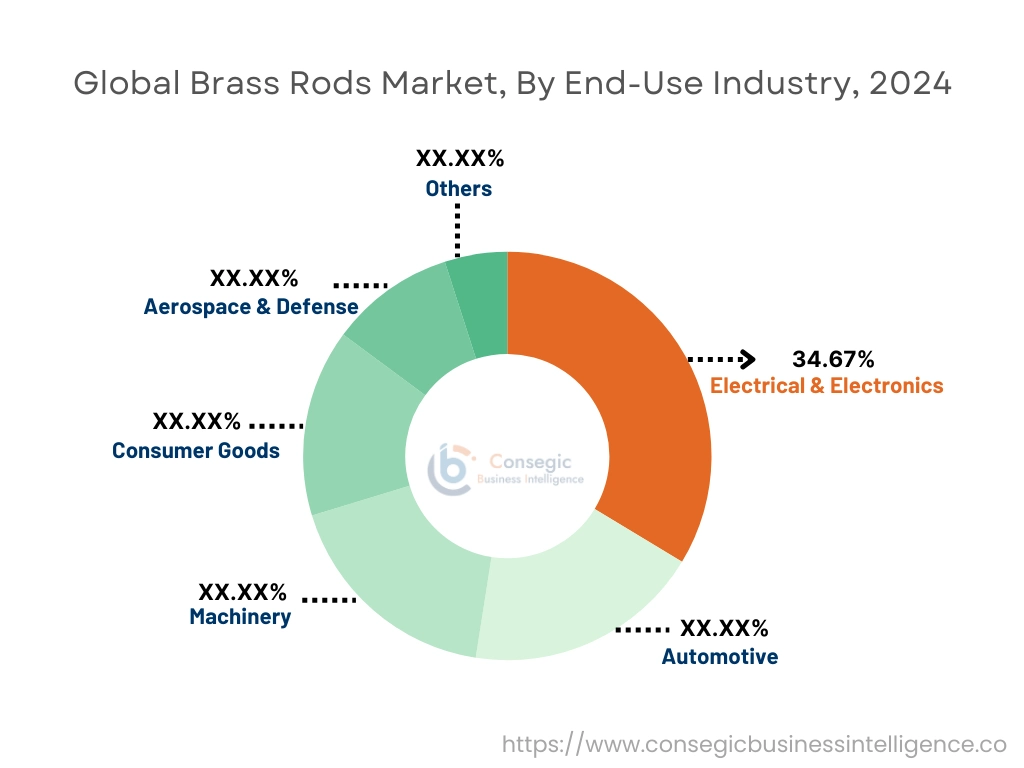
Regional Analysis:
The regional segment includes North America, Europe, Asia Pacific, the Middle East and Africa, and Latin America.
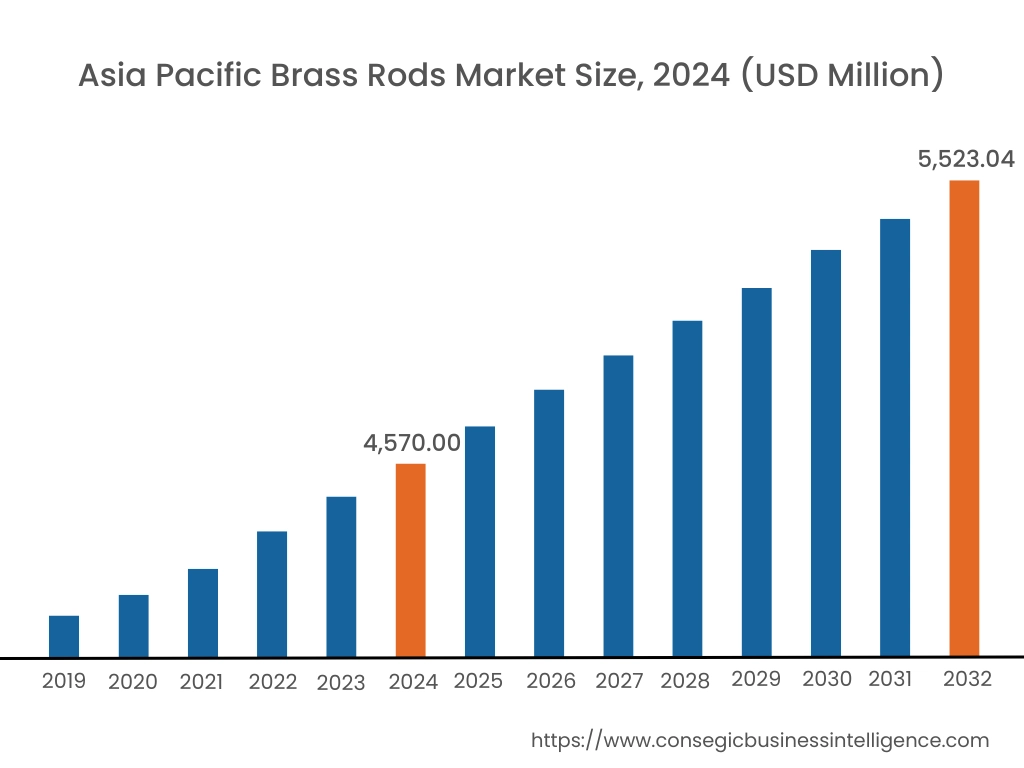
In 2024, Asia Pacific accounted for the highest brass rods market share at 42.33% and was valued at USD 4,570.00 Million and is expected to reach USD 5,523.04 Million in 2032. In Asia Pacific, the China accounted for the brass rods market share of 33.95% during the base year of 2024. More people are moving to cities. Due to this, there is increasing urbanization. These rods are used in plumbing doors and windows. They are also used for decorative fittings. They serve as very strong material. Th increasing construction activities in driving the market in region.
For instance,
- According to Invest India, Indian government investment in construction sector increased by 11.1% in year 2024. This has led to the construction of more buildings and commercial spaces. Rods made from brass are used in fitting, bearings and others.
Moreover, the demand for electrical appliances is increasing in the region. This includes refrigerators, air conditioners, and washing machines. More people are able to afford them. Due to this, manufacturers are increasing production. Rods of brass material are used in making switches, wiring parts, and connectors. This is driving the market in the region.
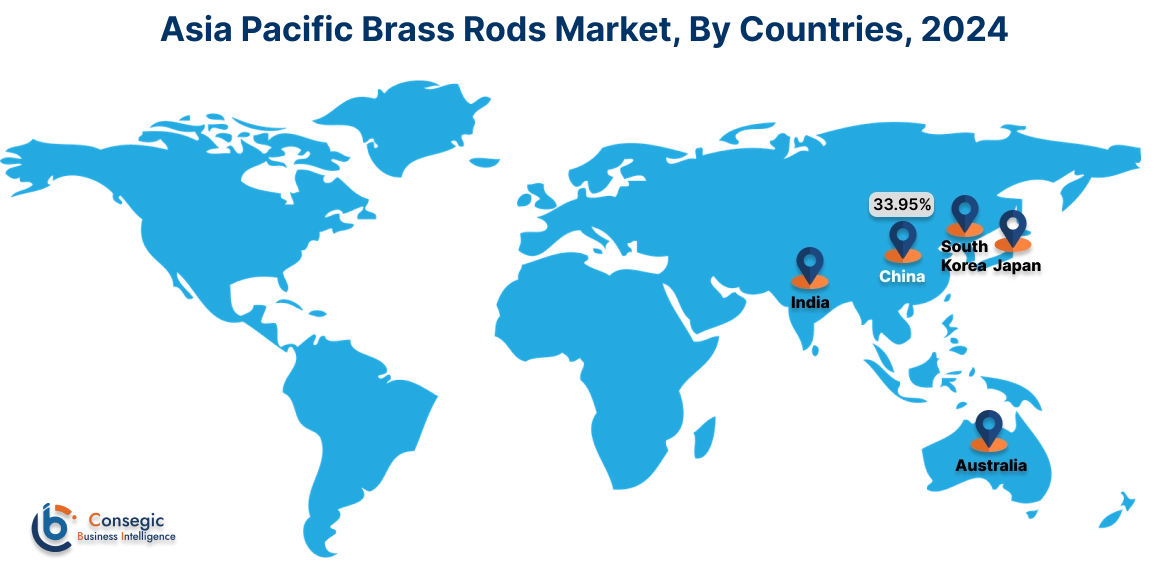
In Europe, the brass rods market is experiencing the fastest growth with a CAGR of 4.2% over the forecast period. In the region, there is an increasing need for electric vehicles (EVs). This increased the need for rods made from brass material. In EV, they are used to manufacture charging ports and battery connectors. Due to their high strength, they are also used to manufacture electrical fittings. Moreover, Europe has a strong focus on sustainability. Brass is 100% recyclable and sustainable. They are seen as eco-friendly material. It reduces waste. It also meets strict environmental rules. This is driving the market in the region.
North America’s brass rods market analysis states that several trends are responsible for the progress of the market in the region. New technology is helping to make brass rods better. Machines now cut and shape brass with more accuracy. This is making it easier to use in electronics, plumbing, and cars. New types of brass are also being developed. They last longer and resist damage. Moreover, in the region another trend is brass rods are used in solar panels, wind turbines, and electric vehicle charging stations. Brass rods are used in solar panels, wind turbines, and electric vehicle charging stations. In wind turbines, brass parts are used in gears and electrical systems.
The Middle East and Africa (MEA) brass rods market analysis states that the region is also witnessing several trends for notable surge. In the region, there is the development of new roads, bridges, airports, and buildings. This is creating a high demand for strong materials. This includes rods developed from brass material. Brass is used in electrical systems, plumbing, and construction fittings. Moreover, governments in MEA are making investments on various projects. This includes smart cities, transportation, and energy systems. They are improving the water supply, electricity, and housing. All these products used brass rods. Brass is needed for making pipes, electrical connectors, and machines.
Latin America's brass rods market size is also emerging. More ships, boats, and ports are being developed in region. The increasing need for rust-resistant materials such as brass is driving the market in the region. These rods are used in ship engines, valves, and fittings. They do not corrode in seawater. Moreover, Companies in Latin America are working together with foreign manufacturers. They are maintaining relations with investors to improve production and technology. These partnerships help to bring better-quality materials. This is driving the market in the region. It also includes new machinery to the region. Local players are producing more rods at lower costs.
Top Key Players and Market Share Insights:
The Brass Rods market is highly competitive with major players providing products to the national and international markets. Key players are adopting several strategies in research and development (R&D) and product innovation to hold a strong position in the global Brass Rods market. Key players in The Brass Rods industry include-
- Wieland Chase (U.S.)
- Mueller Brass Co. (U.S.)
- AES Metals Ltd (UK)
- A. Eredi Gnutti Metalli SpA (Italy)
- Ghidini Trafilerie SPA (Italy)
- Ningbo Jintian Copper Co., Ltd. (China)
- Diehl Stiftung & Co. KG (Germany)
- Munot Metalloys (India)
- Fluhs Drehtechnik (Germany)
- Metalfort Inc. (India)
Brass Rods Market Report Insights :
| Report Attributes | Report Details |
| Study Timeline | 2019-2032 |
| Market Size in 2032 | USD 13,677.66 Million |
| CAGR (2025-2032) | 3.0% |
| By Grade |
|
| By Application |
|
| By End Use Industry |
|
| By Region |
|
| Key Players |
|
| North America | U.S. Canada Mexico |
| Europe | U.K. Germany France Spain Italy Russia Benelux Rest of Europe |
| APAC | China South Korea Japan India Australia ASEAN Rest of Asia-Pacific |
| Middle East and Africa | GCC Turkey South Africa Rest of MEA |
| LATAM | Brazil Argentina Chile Rest of LATAM |
| Report Coverage |
|
Key Questions Answered in the Report
How big is the Brass Rods market? +
In 2024, the Brass Rods market is USD 10,796.12 Million.
Which is the fastest-growing region in the Brass Rods market? +
Europe is the fastest-growing region in the Brass Rods market.
What specific segmentation details are covered in the Brass Rods market? +
Grade, Application, and End-Use Industry segmentation details are covered in the Brass Rods market
Who are the major players in the Brass Rods market? +
Wieland Chase (U.S.), Mueller Brass Co. (U.S.), Ningbo Jintian Copper Co., Ltd. (China), Diehl Stiftung & Co. KG (Germany), and Munot Metalloys (India) are some major players in the market.
